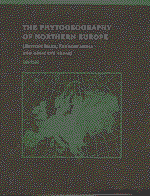Book contents
- Frontmatter
- Contents
- Preface
- Acknowledgements
- 1 Introduction
- 2 Climate
- 3 Edaphic factors
- 4 The geological history of the present European flora
- 5 The atlantic and oceanic elements
- 6 The thermophilic element
- 7 The boreal element
- 8 The arctic, alpine and montane elements
- 9 Endemic, disjunct and centric distribution patterns
- 10 Anthropochorous plants
- Appendix I Calculation of climatic parameters for comparison with plant distributional data
- Appendix II The Northern European species of Flora Europaea with indications of their status and climatic correlations
- Appendix III Arctic species of vascular plants
- Appendix IV Endemic species of vascular plants, bryophytes and lichens
- Appendix V Extra-European disjunctions – bryophytes and lichens
- References
- Index
Preface
Published online by Cambridge University Press: 23 October 2009
- Frontmatter
- Contents
- Preface
- Acknowledgements
- 1 Introduction
- 2 Climate
- 3 Edaphic factors
- 4 The geological history of the present European flora
- 5 The atlantic and oceanic elements
- 6 The thermophilic element
- 7 The boreal element
- 8 The arctic, alpine and montane elements
- 9 Endemic, disjunct and centric distribution patterns
- 10 Anthropochorous plants
- Appendix I Calculation of climatic parameters for comparison with plant distributional data
- Appendix II The Northern European species of Flora Europaea with indications of their status and climatic correlations
- Appendix III Arctic species of vascular plants
- Appendix IV Endemic species of vascular plants, bryophytes and lichens
- Appendix V Extra-European disjunctions – bryophytes and lichens
- References
- Index
Summary
Eilif Dahl had one of the most original and creative minds in plant geography, as well as in plant sociology and mountain ecology. His approach to plant geography went far beyond the description of distribution patterns and the establishment of correlations between distributions and particular climatic variables. He always strove to try to understand what the underlying physiological mechanisms were that influenced and controlled the observed distributional patterns. He proposed that many mountain plants are restricted to high elevations because of their intolerance to high maximum summer temperatures in the lowlands. He suggested that thermophilous species are restricted in their range by temperature dependent ATP production during dark respiration. He hypothesised that many eastern boreal species are absent from western oceanic areas because of the inability of the species to cope with alternating mild and cold periods in winter and spring. He also strongly championed the importance of history, particularly glacial survival on ice-free refugia (nunataks) of arctic plants during the glacial stages, to explain the present-day distributions of several high-arctic species. Throughout his plant geographical studies Dahl brought to bear his wide range of scientific interests and abilities in, for example, physics, chemistry, geology, climatology, meteorology and mathematics, as well as plant ecology and plant systematics.
In 1986 Eilif Dahl told me he was planning to write a book on the plant geography of Northern Europe. I was naturally excited by the idea of a book by Eilif Dahl that would bring together his life's work and ideas on this fascinating topic.
- Type
- Chapter
- Information
- The Phytogeography of Northern EuropeBritish Isles, Fennoscandia, and Adjacent Areas, pp. ix - xPublisher: Cambridge University PressPrint publication year: 1998

